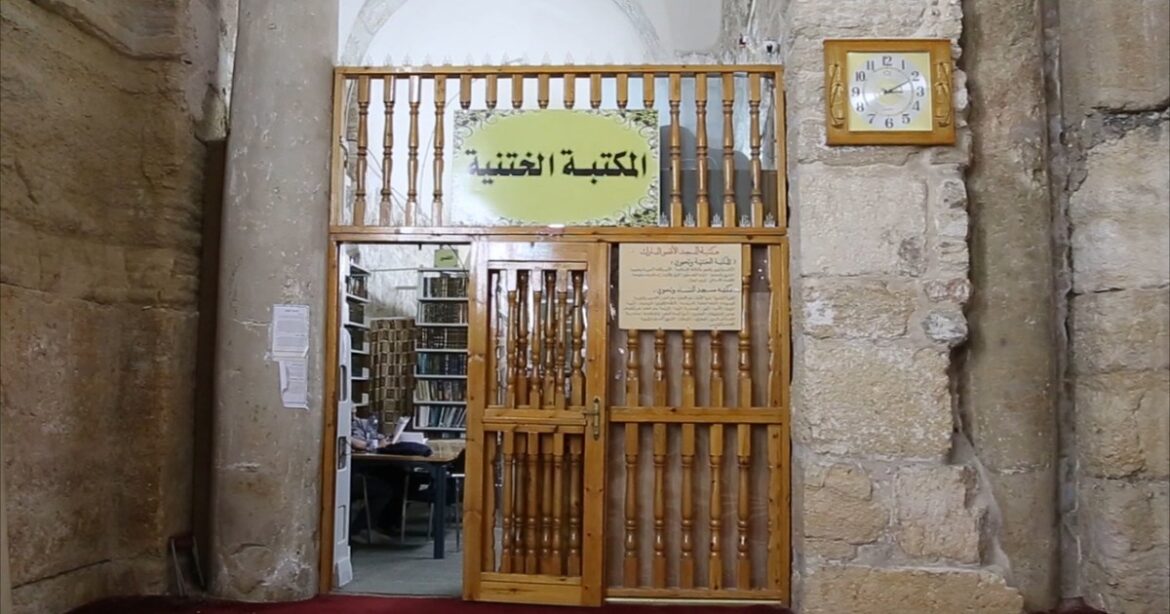The Khatniyya Zawiya building is one of the ancient landmarks of Jerusalem that was built during the era of the Fatimid Empire. It is called the Khatniyya Library or the Khatniyya School. It was rebuilt by Commander Saladin al-Ayyubi and he established a corner in it, as part of his work to fortify and maintain the wall of the city of Jerusalem after its liberation from the Crusaders.
This library played a major role in the intellectual movement in the city of Jerusalem, and a number of senior scholars taught there.
the site
Commander Salah al-Din al-Ayyubi established the Khutaniyyah corner behind the mihrab of the Qibli prayer hall in the blessed Al-Aqsa Mosque directly on the western side. It has an entrance to the right of the pulpit, in addition to an entrance below the Qibli prayer hall from the northern side.
The library is located on the southern side of the Blessed Al-Aqsa Mosque, and is reached via the stairs in front of the Qibli prayer hall, which leads to a long hallway that ends with a giant gate of ancient closed doors known as the Prophet’s Gate.
This gate leads to the Khatani corner, which has become a library.
Label
The name Al-Zawiya Al-Khutniyya was named after a scholar who came from Turkmenistan, northern Iran. In the year 1345 AD, the traveler Ibn Fadlallah Al-Amri came to the city of Jerusalem and visited the zawiya – which was then called Al-Khanqah Al-Saliyah – and said that there was a sheikh in it known as Al-Khutni, and that the zawiya became known after him. In the name of the circumcised corner.
Growing up
The Khutani zawiya was initially established by the Fatimid state, and Saladin al-Ayyubi endowed it in 587 AH 1191 AD, for Sheikh Jalal al-Din Ahmad bin Muhammad al-Shash to worship there and give lessons in knowledge.
The construction of the zawiya dates back to the Fatimid period, and it was part of the Fatimid garrison’s preparations to fortify the gates of Al-Aqsa and the city of Jerusalem before the Crusader invasion.
In the beginning, a small fort and a defensive tower were built to protect the Prophet’s Gate (the double gate). Then the city was occupied by the Crusaders and lasted 88 years, until the Ayyubids liberated it under the leadership of Saladin al-Ayyubi, and he ordered that this fort be transformed into a zawiya for Sufism. The first person to take over as sheikh was Sheikh Abu Bakr Al-Shashi.
Commander Saladin rebuilt it when he fortified Jerusalem and restored its wall after its liberation. The building stones were modest given the state of war the city was going through.
Deprecate and rebuild
The Khatani corner was neglected in the late Ottoman era, and was transformed from a library into a storeroom for saddles and lamps. In the early era of the Supreme Islamic Council, the remains of dust and rubble that resulted from the reconstruction of the blessed Al-Aqsa Mosque were thrown into it. It remained abandoned until 1998 AD, after which it was rebuilt and a center for memorizing the Qur’an was established in it. Al-Karim, and a huge Islamic library.
The Al-Khatniyya corner was transformed into a library in 1998 AD, and books were brought to it to revive it. It is full of precious manuscripts whose ownership is divided between public and private.
The Khatniyya Library is divided into two branches: one contains references on religious and humanitarian topics, and the second is called the “Women’s Mosque,” and there is a section for scientific materials and another for manuscripts that arrived at the library through endowments from scholars of Jerusalem, in addition to a letter addressed by the Endowments Department to the people of Jerusalem, asking them to Donating the ancient manuscripts they own.
Al-Maqdisi Marwan Al-Nashashibi (Abu Adnan) volunteered to buy some books and collect money, and mobilized his efforts to enrich the Khatani Library. After his retirement in 1988 AD, he and his wife devoted themselves to serving Al-Aqsa Mosque. He volunteered to arrange the Qur’an and install lighting chandeliers. He worked as secretary of the Khatani Library for 20 years until his death on the 21st. May 2014 at the age of 90.
The library contains hundreds of thousands of important ancient books, linguistic references, and references from all types of religious and secular sciences.



